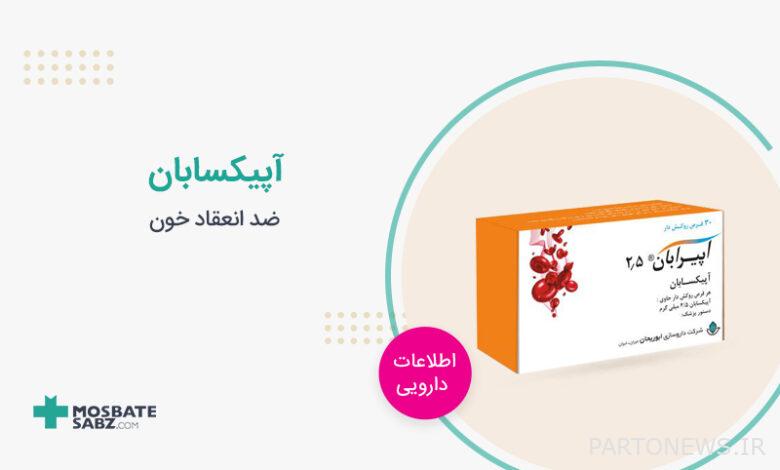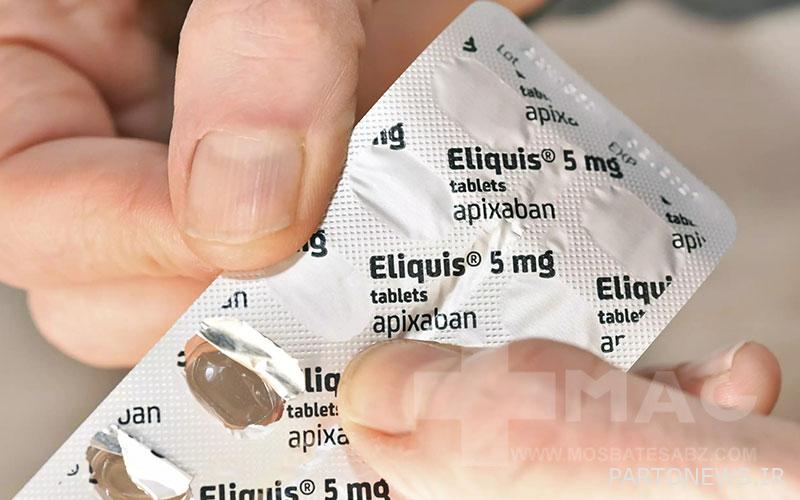What is Apixaban?

Apixaban, as an effective antiplatelet drug, plays an essential role in preventing the formation of blood clots due to incomplete and unstable coagulation. This drug has been introduced as a powerful tool in the treatment of patients with heart diseases due to the reduction of the risk of coronary arteries and cardiovascular events. The use of apixaban not only helps to improve the quality of life of patients with heart diseases, but also greatly reduces the risk of dangerous accidents. In the following, we will review the mechanism of action, indications for use, method of administration, precautions and contraindications for the use of apixaban.
What we read in this article
Apixaban dosage forms
- Tablets: 2.5 mg and 5 mg
Uses of apixaban tablets
Apixaban is used to prevent serious blood clots from forming due to an irregular heartbeat (atrial fibrillation) or after hip and knee replacement surgery. In atrial fibrillation, part of the heart doesn’t beat as it should, a process that can lead to blood clots that travel to other parts of your body (like your lungs or legs) or increase your risk of stroke. In different countries, apixaban is approved to treat certain types of blood clots (deep vein thrombosis-DVT, pulmonary embolism-PE) and prevent their re-formation. In general, Apixaban is an anticoagulant that works by blocking clotting proteins in your blood. .
- The biggest changes that will happen in WhatsApp this yearFebruary 3, 2024
- Applications for locating family and friends on AndroidFebruary 2, 2024
Pharmacological effects and mechanism of action of apixaban drug
A factor Xa inhibitor that inhibits platelet activation by selectively and reversibly blocking the active site of factor Xa without requiring a cofactor (such as antithrombin) for activity. Factor Xa is free and bound to the clot and inhibits prothrombinase activity. This process has no direct effect on platelet aggregation, but indirectly inhibits thrombin-induced platelet aggregation. The blood coagulation cascade depends on the activation of factor X to factor Xa through intrinsic and extrinsic pathways that play a central role in the blood coagulation cascade. Excretion of this drug is 25% in urine and feces as a metabolite and renal excretion is 27% of the total clearance. Also, biliary and direct intestinal excretion helps excretion in feces.
Apixaban dosage
Take apixaban tablets by mouth with or without food, usually twice a day (every 12 hours) as directed by your doctor. If you cannot swallow the tablet whole, you can crush the tablet and mix it with water, apple juice or applesauce and take it right away. If you are using apixaban to prevent blood clots after surgery, the length of treatment will be prescribed by your doctor based on the type of surgery you had. Take this medicine as prescribed by your doctor and avoid sudden discontinuation or excessive increase.
Time to take apixaban tablets
- Apixaban is used to prevent stroke and systemic embolism in non-valvular atrial fibrillation. The recommended dose is 5 mg orally.
- Mild to moderate renal impairment (non-valvular atrial fibrillation), no dose adjustment required.
- Dose for serum creatinine ≥1.5 mg/dL: If patient has 1 additional characteristic of age 80 years or weight 60 kg, reduce dose to 2.5 mg/day.
- ESRD maintained on hemodialysis: 5 mg, if 1 additional feature of age ≥ 80 years or weight greater than 60 kg, reduce dose to 2.5 mg/day.
- The initial dosage for postoperative DVT/PE prophylaxis is 2.5 mg orally 12-24 hours after surgery and the duration of treatment (hip replacement) is 2.5 mg for 35 days. Also, dose adjustment is not recommended for kidney failure, including ESRD, in deep vein thrombosis dialysis.
- Apixaban is recommended by a doctor to treat deep venous thrombosis (DVT) and pulmonary embolism (PE). The recommended dose is 10 mg orally every 7 days, which has been shown to reduce the risk of recurrent DVT and PE after 6 months of initial treatment for DVT or PE.
Precautions
Before taking apixaban, if you are allergic to it or other ingredients in the medicine, avoid using it. This medicine may contain inactive ingredients that can cause allergic reactions or other problems. If you have medical history including liver disease, kidney disease, bleeding problems (such as stomach and intestinal bleeding, bleeding in the brain), blood disorders (such as anemia, hemophilia, thrombocytopenia), recent major injury and surgery, stroke, clotting disorder (antiphospholipid syndrome) and… see a doctor.
- Discontinuation of apixaban in the absence of adequate alternative anticoagulants increases the risk of thrombotic events.
- Safety and efficacy in patients with artificial heart valves have not been studied. Therefore, its use in these patients is not recommended.
- It is not recommended as an alternative to unfractionated heparin for the initial treatment of PE in patients presenting with hemodynamic instability or who may receive thrombolysis or pulmonary embolectomy.
- Avoid simultaneous use with strong dual inducers of CYP3A4 and P-gp. Such drugs reduce the systemic exposure of apixaban.
- In some cases, it increases the risk of bleeding and can cause serious and potentially fatal bleeding. Advise patients of signs and symptoms of blood loss and report them immediately. Discontinue treatment in patients with active pathological bleeding.
- Concomitant use with other drugs that affect hemostasis increases the risk of bleeding (eg, aspirin and other antiplatelet agents, other anticoagulants, heparin, thrombolytic agents, SSRIs, SNRIs, NSAIDs).
- Direct-acting oral anticoagulants (DOACs) are not recommended for use in patients with triple-positive antiphospholipid syndrome (APS). For patients with APS (especially those who are triple positive [مثبت ضد انعقاد لوپوس، آنتی کاردیولیپین و آنتیبادی های ضد بتا 2- گلیکوپروتئین I]), treatment with DOACs is associated with an increased rate of recurrent thrombotic events compared to treatment with vitamin K antagonists.
- This drug prolongs PT and aPTT. However, the changes are small and highly variable and are not useful for monitoring the anticoagulant effect of apixaban.
Apixaban contraindications
- Severe sensitivity (ie, anaphylactic reactions)
- Active pathological bleeding
The risk of use in patients with non-valvular atrial fibrillation
- Early discontinuation of any oral anticoagulant, including apixaban, increases the risk of thrombotic events. If anticoagulation with apixaban is discontinued for reasons other than pathological bleeding or completion of a treatment course, use another anticoagulant.
- An increase in the rate of stroke after discontinuation of apixaban was observed in clinical trials in patients with non-valvular atrial fibrillation.
- If anticoagulation with apixaban must be discontinued for a reason other than pathological bleeding, coverage with another anticoagulant should be strongly considered.
Risk of spinal hematoma/epidural drug apixaban
- There is an increased risk of epidural or spinal hematoma when used with nerve anesthesia (epidural and spinal anesthesia) or spinal puncture (can result in long-term or permanent paralysis).
- The risk is increased with the use of indwelling epidural catheters to administer analgesia or the concomitant use of drugs affecting hemostasis (eg, NSAIDs, platelet aggregation inhibitors, other anticoagulants).
- The risk also increases with traumatic or repeated epidural or spinal puncture. If this occurs, delay administration of apixaban for 48 hours.
- Monitor patients for signs and symptoms of neurological impairment. If a neurological disorder is observed, immediate treatment is necessary. Indwelling epidural or intrathecal catheters should not be removed earlier than 24 hours after the last administration of apixaban. Also, the next dose of apixaban should not be administered earlier than 5 hours after catheter removal.
Apixaban side effects
Nausea, easy bruising, or minor bleeding (such as nosebleeds, bleeding from cuts), digestive problems (internal bleeding), etc. are some of the side effects of Apixaban. If any of these effects persist or worsen, tell your doctor or pharmacist right away. Some of the serious side effects of this drug include unusual fatigue and weakness, unusual pain, swelling and discomfort, unusual bruising, prolonged bleeding from a cut or gum, prolonged menstrual flow, pink and dark urine, coughing up blood, vomiting blood that looks like coffee grounds, Severe headache, dizziness and fainting, bloody and black stools, difficulty in swallowing, etc. See a doctor.
- Blood and lymphatic system disorders: thrombocytopenia (including decreased platelet count)
- Vascular disorders: Hypotension (including procedural hypotension)
- Respiratory, thoracic and mediastinal disorders: epistaxis
- Gastrointestinal disorders: gastrointestinal bleeding (including hematoma and melena), hematochezia
- Hepatobiliary disorders: Abnormal liver function test, increased blood alkaline phosphatase, increased blood bilirubin.
- Renal and urinary disorders: hematuria (including related laboratory parameters)
- Injury, poisoning and complications of the procedure: wound discharge, bleeding at the incision site (including hematoma at the incision site), surgical bleeding.

Apixaban drug interactions
- Category X interactions (avoid): anticoagulants, dabigatran etexilate, edoxaban, Hemin, strong inducers of CYP3A4 and P-gp, mifepristone, omastaxin, rivaroxaban, tea herb, urokinase, verapaxar
- Reduction of apixaban effects by drugs: ivocidanib, mitotane, oritavancin, progestins, sarilumab, ciltuximab, tea herb, telavancin, tocilizumab
- Enhancement of drug effects by apixaban: anticoagulants, collagenase (systemic), deferasirox, deoxycholic acid, ibritumumab tioxane, nintedanib, obinotuzumab, omastaxin, rivaroxaban, vitamin K antagonists
- Increased effects of apixaban by drugs: inotresin, limaprost, mesoglycan, mifepristone, naproxen, nonsteroidal anti-inflammatory drugs (COX-2 selective), omega-3 fatty acid, sodium pentosan polysulfate, prostacyclin analogs, salicylates, sugammadex, sulodexide, thrombolytic drugs, tibolone, tipranavir, urokinase, vitamin E (systemic), verapaxar, zanubrutinib
Taking apixaban tablets during pregnancy and breastfeeding
There are no adequate and well-controlled studies in pregnant women, treatment may increase the risk of bleeding during pregnancy and delivery. Pregnancy increases the risk of thromboembolism, which is higher for women with underlying thromboembolic disease and some high-risk pregnancy conditions. Published data show that women with a previous history of venous thrombosis are at high risk of recurrence during pregnancy. Treatment with apixaban should only be done during pregnancy if the potential benefit outweighs the potential risk to the mother and fetus.
The effect of apixaban on breastfeeding
There are no data on the presence of drug metabolites in human milk, its effects on the nursing infant, or its effects on milk production. The drug or its metabolites were present in the milk of rats, and rats excreted apixaban in milk (12% of the maternal dose). Because human exposure through milk is unknown, instruct women to discontinue breast-feeding or initiate alternative therapy, taking into account the importance of the drug to the mother.
Apixaban storage conditions
Apixaban should be stored at room temperature away from light and moisture. Also, it should be kept away from children and animals as much as possible, and in case of damage or expiration date, dispose of it properly.
The last word about the drug apixaban
In this article from Positive Green Online Pharmacy magazine, we discussed a wide range of apixaban as a new generation blood anticoagulant. Apixaban, with its unique mechanism of action and superior benefits in preventing the formation of blood clots and the possibility of vascular accidents, has been proposed as a vital tool in the treatment of patients with cardiovascular diseases. This article, as a new comprehensive and informative guide in the field of anticoagulants, aims to increase knowledge in the medical community and is based on reliable research and up-to-date information.
Site source: Medscape

